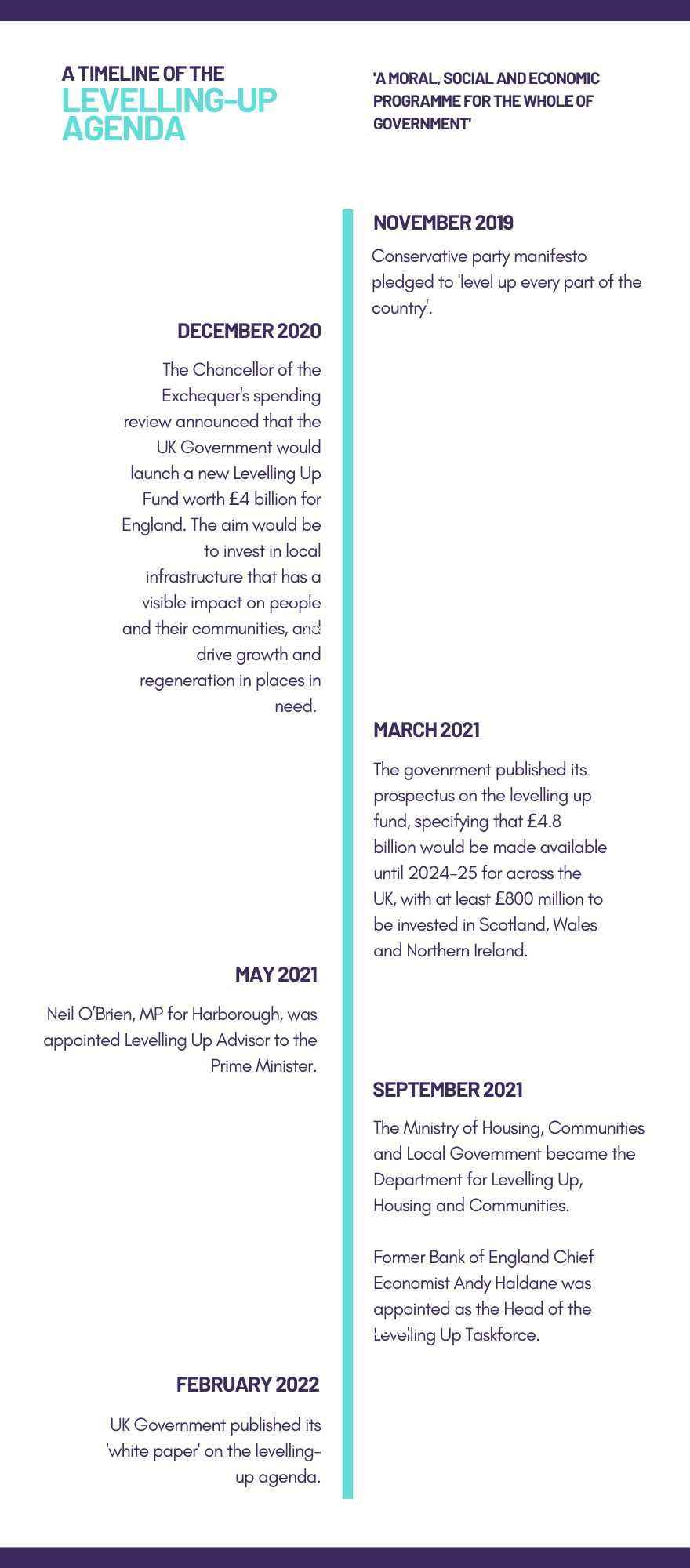The 2021 UK drug strategy incorporated references to the ‘levelling-up agenda’ – a government programme of work to reduce geographic, economic, social, and health inequalities. Read on for an overview of the proposed strategies for levelling-up Britain, and the implications for the addiction sector.
The UK Prime Minister has described the levelling-up agenda as the “defining mission” of the current UK Government. It is intended to be a “root and branch reform of government and governance”, in a bid to “spread opportunity more equally across the UK”.
The levelling-up agenda has been implemented and promoted to varying degrees over the past few years (see timeline). For example, ‘levelling up’ was mentioned in the Conservative party’s 2019 manifesto, it underpinned a funding commitment of £4.8 billion in late 2020 to support communities with regeneration projects, and it prompted the appointment of former Bank of England Chief Economist Andy Haldane to Head of the Levelling Up Taskforce in September 2021.

However, the government has only recently provided detail about what ‘levelling up’ means as a formal policy, through the release of its 332-page ‘white paper’ (a type of policy paper that enables a government to lay out proposals for future legislation and provide a basis for consultation with stakeholders).
What can we learn from the white paper?
The policy paper, published on 2 February 2022, explains the different types of geographical disparities that exist across the United Kingdom, what can be gleaned from the failures and successes of previous policy approaches, and the government’s four aims for ‘levelling up’ the UK:
- To boost productivity, pay, jobs, and living standards by growing the private sector: this is about improving living standards, research and development, transport, and digital connectivity.
- To spread opportunities and improve public services: this is about improving education, skills, health, and wellbeing.
- To restore a sense of community, local pride and belonging: this is about communities having pride in place, improving housing, and reducing crime.
- To empower local leaders and communities: this is about supporting local leadership.
These aims are supported by 12 ‘targets’ or ‘missions’, which all have an end date of 2030. Collectively, these convey the government’s ambition to “improve productivity, boost economic growth, encourage innovation, create good jobs, enhance educational attainment and renovate the social and cultural fabric of those parts of the UK that have stalled and not – so far – shared equally in [the UK’s] success”.
What does this mean for the addiction sector?
Readers of the most recent drug strategy, published in December 2021, may remember that the phrase ‘levelling up’ was sprinkled throughout the text.
“Addressing the complex relationship between drugs, crime, health outcomes and deprivation means we will make a substantial contribution to the government’s defining mission of levelling up.”
Although the levelling-up agenda wasn’t well-defined at this point, these references in the drug strategy gave a hint to people with a stake or an interest in substance use policy that the levelling-up agenda would seek to address the ‘problem’ of illicit drugs.
Indeed, the topic of drugs appears several times in the white paper – primarily so in the context of crime and antisocial behaviour, which are depicted as ‘pulling down’ communities. To level up these areas, the white paper commits to the following aim and target:
Aim: “Restore a sense of community, local pride and belonging, especially in those places where they have been lost.”
Target: “By 2030, homicide, serious violence and neighbourhood crime will have fallen, focused on the worst affected areas.”
Both the white paper and the 2021 drug strategy frame illicit drugs as a criminal justice issue, and use the same type of language about drugs and drug-related crime ‘blighting’ communities. The drug strategy also, however, sets out the need to address illicit drugs as a health issue, by delivering “a world-class treatment and recovery system”.
For this reason, the levelling-up white paper by no means supersedes the strategic direction of the drug strategy; it gives only a partial view of the perceived impact of illicit drugs on society, and the necessary solutions. However, the levelling-up white paper may provide the addiction sector with a better understanding of the political and ideological drivers of government policy over the next few years, and how these might directly or indirectly influence drug policy.
Recommended reading: an overview of Professor Dame Carol Black’s major review of drug policy, and a brief analysis of the UK Government’s 10-year drug strategy.
The opinions expressed in this post reflect the views of the author(s) and do not necessarily represent the opinions or official positions of the SSA.
The SSA does not endorse or guarantee the accuracy of the information in external sources or links and accepts no responsibility or liability for any consequences arising from the use of such information.

